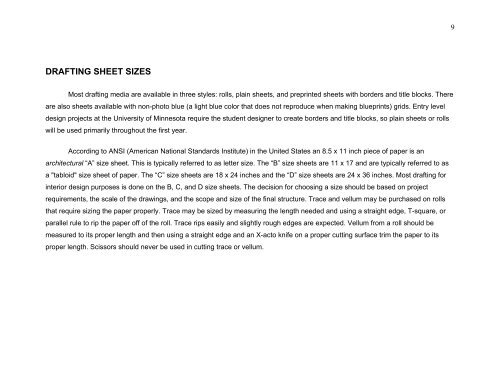Basic Drafting Standards - Interior Design - University of Minnesota
Basic Drafting Standards - Interior Design - University of Minnesota
Basic Drafting Standards - Interior Design - University of Minnesota
You also want an ePaper? Increase the reach of your titles
YUMPU automatically turns print PDFs into web optimized ePapers that Google loves.
DRAFTING SHEET SIZES<br />
Most drafting media are available in three styles: rolls, plain sheets, and preprinted sheets with borders and title blocks. There<br />
are also sheets available with non-photo blue (a light blue color that does not reproduce when making blueprints) grids. Entry level<br />
design projects at the <strong>University</strong> <strong>of</strong> <strong>Minnesota</strong> require the student designer to create borders and title blocks, so plain sheets or rolls<br />
will be used primarily throughout the first year.<br />
According to ANSI (American National <strong>Standards</strong> Institute) in the United States an 8.5 x 11 inch piece <strong>of</strong> paper is an<br />
architectural “A” size sheet. This is typically referred to as letter size. The “B” size sheets are 11 x 17 and are typically referred to as<br />
a "tabloid" size sheet <strong>of</strong> paper. The “C” size sheets are 18 x 24 inches and the “D” size sheets are 24 x 36 inches. Most drafting for<br />
interior design purposes is done on the B, C, and D size sheets. The decision for choosing a size should be based on project<br />
requirements, the scale <strong>of</strong> the drawings, and the scope and size <strong>of</strong> the final structure. Trace and vellum may be purchased on rolls<br />
that require sizing the paper properly. Trace may be sized by measuring the length needed and using a straight edge, T-square, or<br />
parallel rule to rip the paper <strong>of</strong>f <strong>of</strong> the roll. Trace rips easily and slightly rough edges are expected. Vellum from a roll should be<br />
measured to its proper length and then using a straight edge and an X-acto knife on a proper cutting surface trim the paper to its<br />
proper length. Scissors should never be used in cutting trace or vellum.<br />
9


